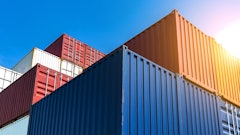
The average container prices in China have reached its highest in two years, at $3,600 this week for 40-foot-high cube cargo worthy containers in China. These prices were somewhere around $1,700 in March – April, indicating a 112% increase in a span of two months.
While the average container prices (for purchasing containers) are on a significantly upward trend, the average one-way pickup charges (for leasing containers) continue to develop at a staggering rate so far in June.
“While prices and rates are significantly up, trading volumes have decreased as buyers are becoming more cautious. This trend potentially indicates a potential reversal of prices in the near future, as the market adjusts to the current disruptions and the high levels of volatility,” says Christian Roeloffs, co-founder and CEO of Container xChange.
Key takeaways:
- Overall, the pickup charges doubled since November until June Ex Shanghai to key ports in the United States. Shanghai to New York rates were around $568 in November 2023, which are now at $1,200 thus far. Shanghai to Oakland rates were $370 in November 2023, and are now at $1,663. Shanghai to Los Angeles rates were $643 in November 2023, reaching to $1,107, and Shanghai to Long Beach pickup charges also spiked from $610 to $1,230 in the same duration.
- This uptick in leasing rates offers positive impact to U.S. retail trends on China container demand. For example, The Monthly Retail Trade Survey shows a consistent rise in U.S. retail inventories, from $769.3 billion in January to $793.5 billion in April. Significant increases are seen in sectors like motor vehicle, parts dealers and building materials.
- In May, retail sales increased by 0.1% month-over-month and 2.3% year-over-year, with core retail sales (excluding automobile dealers, gasoline stations, and restaurants) rising by 0.3% month-over-month and 2.9% year-over-year.
- China's ports recorded a 9% YoY increase in container throughput in the first four months of 2024, handling 104.03 million TEUs. Foreign trade cargo throughput increased by 9.1% YoY.
- Total cargo throughput reached 5.55 billion tons; a 5.2% rise compared to the same period last year.
- While the container shipping sector is not directly impacted by these electric vehicle (EV) tariffs, this development indicates an early signal of potential broader trade tensions. If the proposed tariffs are implemented, the cost of exporting Chinese EVs to Europe will rise, possibly leading to a tariff war. This escalation could result in increased tariffs on a wider range of goods, impacting global supply chains. Higher tariffs and trade barriers could lead to delays and additional costs in the supply chain, causing inefficiencies in container utilization and higher operational costs for shipping companies.
“Despite the current tariff dispute, the long-term outlook for China's container market remains cautiously optimistic. The positive trends in U.S. retail demand and robust growth in China's port throughput suggest sustained demand for container shipping services. However, the resolution of the EU-China tariff dispute will be crucial in shaping the short-to-medium-term market dynamics,” says Roeloffs. “Container shipping companies should prepare for potential shifts in trade patterns by diversifying their routes and enhancing logistics capabilities in other growing markets, such as Southeast Asia and South America. Investing in technology and infrastructure to improve efficiency and reduce costs will be critical in navigating the potential market volatility and maintaining competitiveness.”

























